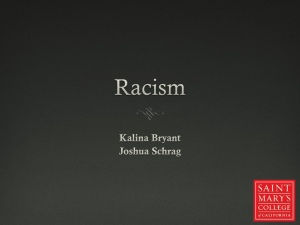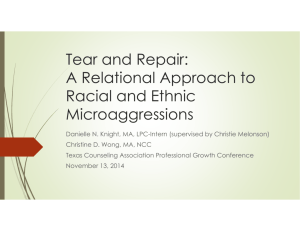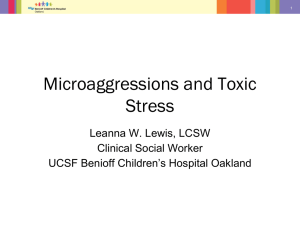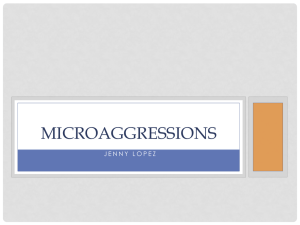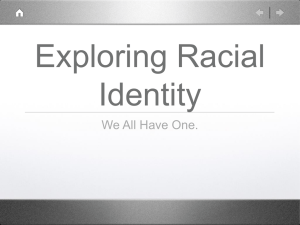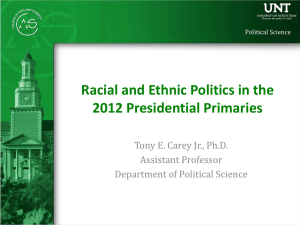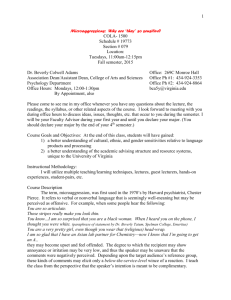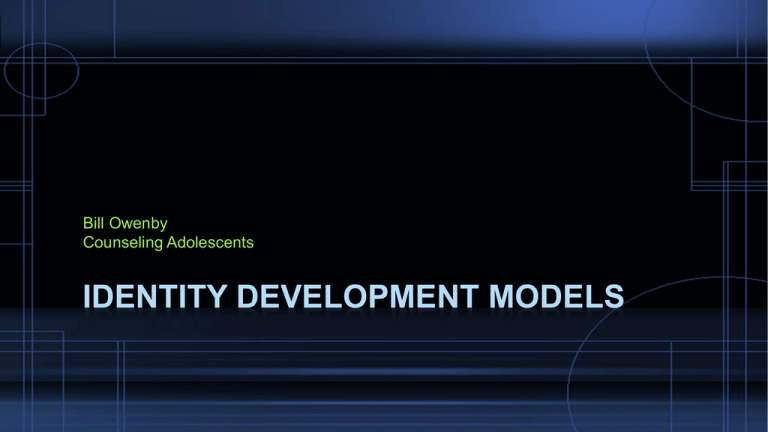
Bill Owenby
Counseling Adolescents
IDENTITY DEVELOPMENT MODELS
Initial thoughts
What does “Identity Development” sound like?
Initial thoughts
Who are some people you can think of when with think
‘identity development’ and or ‘models’?
Why were models developed?
Who do they assist?
Initial thoughts
Now, add in the cultural aspect; what do you think is the
process one goes through, particularly as a child?
Before a definition and explanation…..
First, think about what your own uniqueness as an
individual
Could be related to:
Race
Ethnicity
Sex
Disability(s)/Abilities
Age
Culture
What else? Others you can think of?
Before a definition and explanation……
Now, think of your own process of identity development
you experienced
What do you remember?
Who do you remember?
What did you feel?
Who did this impact, including yourself? In other words, how
were you treated at each step and how does each previous step
contribute to the next?
Can’t think of any?
Examples
Ever traveled to another country?
-possibly more important, why did you go there and leave your
current residence?
If not another country, how about moved across the country?
Or across the state? Even across the city? Different culture?
Example 2
Ever joined a club/team?
What were the expectations from others? From you?
How were you treated? How were you avoided?
How did you become included?
(please consider these as only topical and limited examples for
an initial point of this model)
Why identity development?
Derald Wing Sue (2001) proposed a Tripartite Model of
Personal Identity
This model can be used to describe 3 levels included in identity
development:
First Level
Individual:
each person is unique in genetic makeup, personality, and personal
experience (individual differences set us apart from other human beings)
Examples: hair color, introvert/extravert, etc.
Other examples??
Second Level
Group: focuses on the basic similarities and differences among
individuals (society divides us up into groups based on various
demographic characteristics, therefore a part of our identities is based
on our membership in these groups)
Examples: Culture, neighborhood, sex, etc.
Why is sex in this level and not the first level?
Third Level
Universal: there are characteristics that we share with all other human
beings such as biological needs (food/water), physical similarities
(anatomical similarities), common life experiences (birth/death), and
common practices or behaviors (i.e.-the use of language for
communication)
Examples: Maslow Hierarchy of Needs?
Third Level (cont.)
Why is identity development important?
Can be used to explain the theory of self-concept
defined as a collection of beliefs about oneself.
Also defined through the question “Who am I?”
Carl Rogers coined the term ‘3 selves’ which include:
Ideal- Who you strive to be
Actual- Who you are at the present moment
Perceived- Who you are in the eyes of others
How do we know it exists?
Ever had an identity crisis?
Remember Erikson’s Psychosocial stages?
Most particularly (for teenagers)…….
Name of Stage
Conflict
Adolescent (12-18)
Identity vs. Role Confusion- Teens need to
develop a sense of self and personal identity.
Success leads to an ability to stay true to
yourself, while failure leads to role confusion and
a weak sense of self.
Our to think about ourselves…..
Stage
Conflict
Young Adulthood (19-40 years old)
Young adults need to form intimate, loving
relationships with others; success in this conflict
leads to intimacy, while failure results in
loneliness and isolation
Middle Adulthood (40-65)
Adults need to create and or nurture things that
will outlast them, i.e. children and or an impacting
career that benefit others (a legacy if you will).
Success leads to feelings of usefulness and
accomplishment, while failure results in shallow
involvement in the world
Definition: Cultural Identity Development
Phinney (1990) describes ethnic identity “as a complex
construct including a commitment and sense of belonging
to one’s ethnic group, positive evaluation of the group,
interest in and knowledge about the group, as well as
involvement in activities and traditions of the group.”
Phinney (1989) reports further definition surrounding the
examination and questioning of preexisting attitudes and
assumptions as a necessary step toward identity
achievement.
Other models for future review…..
J. Kim (1981) Asian American identity development
A.S. Ruiz (1990) Hispanic identity development
W.E. Cross (1971) Cross model of Black identity
development
Root (1990) developed a Multiracial model of identity
development based out of the increase in multiracial
couples and children over the last three decades
Racial/Cultural Identity Development Model
(Sue & Sue, 2008) (previously called Minority Identity
Development (MID) model)
Stage 1
Conformity
Individuals exhibit a preference for the dominant cultural values
over their own. Individuals identify with and refer to the
primary/dominant culture. Downplaying and feeling negative
about one’s own culture is part of this stage and by extension,
their identity development.
(Saved By The Bell reference)
Racial/Cultural Identity Development Model
Stage 2
Dissonance- in this stage, the individual has an encounter or
experience that is inconsistent with culturally held beliefs,
attitude, and values from stage 1 (conformity).
Ex: someone who is ashamed of their culture encounters someone
who is proud of their heritage. Typically denial sets in, and
questioning of one’s beliefs are initiated.
Ex: The assassination of MLK Jr; this caused the shift of many African
Americans to move from passive conformity stage to a dissonance
stage.
Racial/Cultural Identity Development Model
Stage 3
Resistance and Immersion- In this stage, a person typically feels
anger, guilt, and shame at the oppression and racism that they
previously accepted from stage 1 (conformity).
This stage is marked by an endorsement of one’s original
culturally-held views and rejects the dominant view they
previously held.
Racial/Cultural Identity Development Model
Stage 4
Introspection- During this stage, individuals devote more time
and energy towards understanding themselves as a part of the
minority group at a deeper level.
In contrast to the intense reactivity at the previous stage (3Resistance and Immersion), one becomes more pro-active in
defining and discovering their sense of self not only as an
individual, but as a part of a group.
Racial/Cultural Identity Development Model
Stage 5
Integrative Awareness- This stage includes a sense of security
and the ability to appreciate positive and negative aspects of
both their own and dominant cultural differences and similarities.
Individuals have typically resolved conflicts in previous stages
and possess feelings of control and flexibility, in addition to
continuously trying to eliminate forms of oppression.
So……
Why stages?
How are they useful to use
Personal
Professional
Therapy implications
Awareness of this model and one’s identity development
can attribute to such areas as:
Stereotypical transactions and assumptions may impact the
therapeutic relationship
What you feel is the best way to assist may be insulting to someone
different than you
When providing services to someone different than you culturally, is
it best to keep that individual and ‘push through’ or place with
someone similar culturally?
Microaggressions are common in everyday language at times
But what is a microaggression? Sue (2013)
Simply stated, microaggressions are brief, everyday exchanges
that send demeaning messages to marginalized groups.
In the classroom, students of color, for example, often describe
microaggressions as a pattern of being overlooked, underrespected and devalued because of their race.
When racial microaggressions occur, they present a highly
charged racial situation that challenges both teacher and students
alike.
The perpetrators (whether teachers or other students) are often
unaware that a microaggressive event, incident or communication
has occurred. They may, however, sense that something is
brewing but be unable to identify or articulate it.
Microaggression examples
Racial Microaggressions
A Black student is complimented by the professor as being articulate and bright.
(Hidden Message: Most Blacks are inarticulate and lack intelligence.)
A third generation Asian American student is complimented by a White classmate
for speaking such “good English.”
(Hidden Message: Asian Americans are perpetual aliens in their own country.)
Gender Microaggressions
A female resident (physician) wearing a stethoscope is mistaken by medical
students for a nurse.
(Hidden Message: Women should occupy nurturing and not decision-making roles. Women
are less capable than men.)
Male students in private refer to a female professor as a “bitch” while their male
counterparts are described as “decisive and assertive teachers.”
(Hidden Message: Women should be passive and allow men to be decision makers.)
Microaggression examples
Sexual Orientation Microaggressions
Students in class refer to a fellow straight student as “gay” (“That’s so gay!”)who is socially ostracized.
(Hidden Message: People considered weird, strange, deviant or different are “gay.”)
A lesbian client reluctantly discloses her sexual orientation to a straight counselor trainee by stating
that she was “into women.” The counselor indicates he is not shocked by the disclosure because he
once worked with a client who was “into dogs.”
(Hidden Message: Same-sex attraction is abnormal and deviant.)
Other Socially Devalued Group Microaggressions
When bargaining over the price of a used book, one student says to the other “Don’t try to Jew me
down.”
(Hidden Message: Jews are stingy and moneygrubbing.)
A blind student reports that the professor and fellow students raise their voices when speaking to him
in class. He responds by saying “Please don’t raise your voice; I can hear you perfectly well.”
(Hidden Message: A person with a disability is defined as lesser in all aspects of physical and mental functioning.)
Therapy implications
Premature termination rates are higher amongst minority clients
due to counselor’s unawareness/biasedness towards one’s own
culture (ethnocentrism)
Why? Return rate of minority clients are lower due to the
counselor’s inability to assess their identity accurately
Therapy implications
Sociopolitical influences can have an impact on one’s identity
development
Protests, marches, sit-ins, police force, profiling, assumptions in
general; all surrounding oppression thus impacting identity
Study on how conformity and identity are
prevalent in society
Clark and Clark (1947)
2 dolls- 1 white and 1 black
Asked both white and black children:
Which one they preferred?
Which one was ‘bad’?
Which one looked like them?
What were the results?
What techniques might you consider for an
individual seeking counseling?
What could an adolescent individual in counseling
therapeutically ‘look’ like?
Anxiety
Conduct Disorder
Depression
Learning Disorder
Low Self Esteem
Oppositional
School Refusal
Anger/fighting
What else have you seen thinking back to your own clientele?
Techniques in Therapy
Depends!
Your technique depends on numerous factors:
Your background (such as…..?!)
Their background
Your approach
Their needs
Your style
Their interpersonal style
Your expectations
Their age and cognitive capabilities
Recommendations for Reading
If you are interested in learning more about Adolescent
interviewing and counseling skills, go to the Chima
Bldg./Dept of Counseling Clinic library and check out:
Fontes, Lisa A. (2008). Interviewing Culturally Diverse Children
and Adolescents. Interviewing Clients Across Cultures (pp. 198226). The Guilford Press, NY.
Anything you can get your hands on, as there is little information
out there not only for Best Practice with children/adolescents,
but culturally diverse children and adolescents
My next lecture will cover Best Practice for culturally diverse
children and adolescents
What about you?
Does your own personal biases get in the way?
How might they come about in counseling?
Have you gone through this yourself?
What if you’re thinking “But I’m part of the dominant culture”?
How do you know that? How do you define yourself and compare for
confirmation of the dominant culture?
Review:
Why is it important to know this?
Helps with identifying social and personal biases and thoughts
that could impact the relationship
Helps everyone; both inside and outside of the office. If change
starts with the individual, how will you change to help others?
Majority/White Identity Development Model
Overall question in mind throughout today:
What does it mean to be white?
(can be thought of and responded by anybody)
Why Important to identify this?
Regardless if you fall into this ‘group’ or not, it is still
important to see your reactions/responses to such a
question
Research says……
The level of racial identity awareness, or lack thereof, is
predictive of racism (Pope-David & Ottavi, 1994)
This means that they less aware one is of their identity, the more
likely there were to exhibit increased levels of racism!
Further research shows that one’s racial identity is related to their
readiness for training in multicultural counseling (Carney & Kahn,
1984).
Various models of Majority Identity
Development
Hardiman White Racial Identity Development (1982)
Helms White Racial Identity Development (1984)
Sue & Sue White Racial Identity Development Descriptive
Model (1990)
Focus of today
A Descriptive Model
7 stages, or ‘statuses’ a person within the dominant
culture transitions through, or considered a ‘looping and
recycling’ approach
White Identity Model of Development
Developed from a curiosity to understand how the
dominant/white culture developed at the time to an
increase in minority/culturally different population
Similar to other identity developments, yet different
Stage 1
Naïveté phase:
Typically within the first 3 years of life
One is usually neutral to differences, and exhibits a curiosity for
differences in culture
Between ages 3-5, a white child begins to associate positive
ethnocentric meanings to their own, and negative ones to others
Why?! (or how?)
Stage 2
Conformity phase:
One’s attitudes and beliefs are considered very ethnocentric, typically
based on trust and faith that others, usually older and in masses,
have provided them with accurate information
Considered a ‘white superiority and minority inferiority’ thought
process
One will identify themselves as white, but deny belonging to a
particular race; this alleviates responsibility for perpetuating a racist
system
Considered with statements such as ‘we are all the same under our skin’;
‘we should treat everyone the same’; ‘problems wouldn’t exist if minorities
would only assimilate’; particularly in the helping professional, this is
considered a color-blindness approach, where all theories are culturally
sound and universal.
Stage 3
Dissonance phase:
Where a thought, or more impactful, a situation arises within a white
person that demonstrates that ‘not all are treated equal’
Ex: thinking ‘I treat all people equally’, but then an African American
person moves next door, or dates your child, etc.
With the increased reality, a person typically feels uncomfortable in
the form of guilt, shame, anger, depression, and feelings of
helplessness
Hear a racist comment or see a racist act, but does not do anything to
correct it due to the typical rationalization of one’s inactivity by now
believing ‘I am only one person, what can I do to correct a systemic
problem?’
Stage 4
Resistance and Immersion phase
Awareness of all around you!
This is the stage where one’s eyes are opened up, and sees all
the racial stereotyping, whether direct or indirect, conscious or
unconscious in our society (advertising, clothing, food)
Typically anger at friends/family for providing a false reality
Guilt at self for having be a part of such oppressive system
Negative feelings about being white are presented
White liberal syndrome- one of two roles develop: protector or
overidentificator.
Stage 5
Introspective phase
No longer denying that one has participated in the oppressive,
‘white privilege’, ‘racism does not exist’ mentality
One becomes more involved through curiosity, independence,
and desire to change how one identifies with their culture and
race, rather than motivated by denial, anger, and guilt.
This is the stage one typically considers questions such as:
‘what does it mean to be white?’; who am I in relation to being
white?’; who am I as a racial/cultural being?’
Stage 6
Integrative & Awareness phase
Characterized as
1. understanding the self as a cultural being
2. aware of sociopolitical influences on racism
3. appreciating cultural diversity
4. becoming more committed to eradicating oppression
One’s identity becomes more internalized through valuing
multiculturalism, comfortable around members of many groups,
and comfortable in a society that is marginally accepting lf
integrative and aware white persons
Stage 7
Commitment to Antiracist Action phase
Where one sees wrong and actively works towards correcting it
Educating family, friends, others and attempts to correct in social and
societal areas
Comes with cost
Can be lonely; family and friends may ostracize this person, following the
concept of ‘don’t rock the boat’, threats of disownment, labeled a
troublemaker, denial of professional advancements
Think of as a cultural whistleblower
Underlying joke: the ultimate white privilege is the ability to
acknowledge racism and do nothing about it.
Comparisons of both models
Majority
1.
2.
3.
4.
5.
6.
7.
Naïveté
Conformity
Dissonance
Resistance & Immersion
Introspective
Integrative Awareness
Commitment to Antiracist Action
Minority
1.
2.
3.
4.
5.
Conformity
Dissonance & Appreciating
Resistance & Immersion
Introspection
Integrative Awareness
Which is it?
Are we a ‘melting pot’ or a ‘diverse salad’ society?
Thoughts? Responses?
Discussion
After reviewing the Identity Development Models, now
consider your own example
Thoughts
Questions
Concerns
Clarifications
Reflection discussion
1. What thoughts came up while you were reflecting upon
your example?
2. What feelings came up?
3. What did you take away from this that you did not have
before completion?
4. How will your experience today be useful in the future with
clients?
5. Is there such a thing as a ‘bad versus ‘good’ stage?
6. Are these stages progressive, or is an individual allowed to
stay where they are at? Why?
Final thoughts
Even though they are considered ‘stages’, try to view
them as ‘statuses’
Why?
Stages indicate progression; progression indicates ‘getting better’;
getting better indicates one was unhealthy; all not true!
Final thoughts
As you have experienced, it is difficult to place one in a
stage, as well as identify how to assist one when
experiencing difficulties in a stage.
The point, as this model is but one extension of
multicultural counseling theory, is to be mindful that
everyone, not just those ‘different’ than you, is unique.
Treat others where they are at, what they need, and not
to tell them what to do.
References
Clark, Kenneth B. and Clark, Mamie P. (1947). Racial identification and
preference among negro children. In E. L. Hartley (Ed.) Readings in
Social Psychology. New York: Holt, Reinhart, and Winston.
Fontes, Lisa A. (2008). Interviewing Culturally Diverse Children and
Adolescents. Interviewing Clients Across Cultures (pp. 198-226).
The Guilford Press, NY.
Pope-Davis, D.B., & Ottavi, T. M. (1994). Examining the association
between self-reported multicultural counseling competencies and
demographic and educational variable among counselors. Journal
of Counseling and Development, 72, 651-654.
Sue, D.W., & Sue, D. (1990, 2001, 2008). Counseling the
culturally different: Theory and practice. New York: Wiley.

